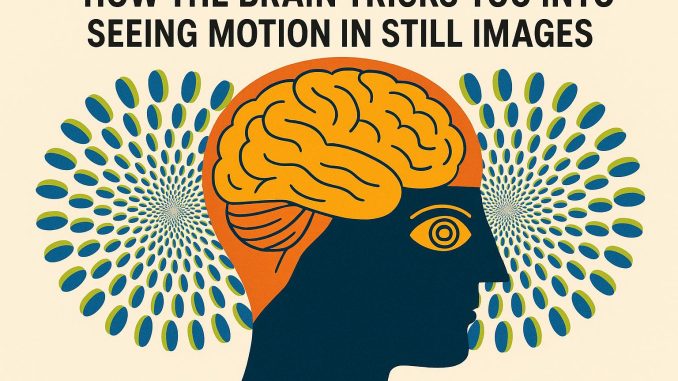
Understanding the Illusion of Motion in Still Images
The phenomenon where the brain perceives motion in static images is a captivating aspect of human perception. This optical illusion arises from the interplay between visual cues, brain processing, and our past experiences with movement. Such illusions have intrigued scientists and artists alike, prompting investigations into the underlying mechanisms.
The Role of Visual Cues
Certain visual characteristics in an image can trick the brain into “seeing” motion. Elements like repetitive patterns, contrasting colors, and strategically placed shapes can create a sense of movement. These visual cues exploit the brain’s natural tendency to predict changes in our environment. For example, swirling patterns or lines that converge and diverge can simulate the sensation of movement due to their dynamic layout. These visual effects are commonly employed by artists and designers who wish to instill a sense of dynamism in their static creative works.
When an artist uses contrasting colors, they are not merely adding aesthetic appeal to their work; they are instigating a visual phenomenon that communicates energy and motion, influencing how we perceive what is in front of us. Similarly, repetitive patterns can create rhythms that mimic the flow and progression of movement. When elements in an image guide our eyes along a certain path, the effect of perceived motion is achieved, as our brains take visual cues and transform them into motion-like sensations.
How the Brain Processes Still Images
The human brain processes visual information through complex networks of neurons that interpret color, shape, and spatial orientation. When viewing a static image, these networks can sometimes misinterpret visual signals due to inherent biases and expectations about how the world typically behaves. The brain might expect movement from a sequence of signals, even if none exists. This expectation can create the illusion of movement.
The brain’s visual system relies heavily on a continuous stream of updated sensory inputs. In the absence of actual motion, our brains sometimes become overzealous, attempting to interpret signals that may not necessitate change or motion. This propensity is a byproduct of intricate neural mechanisms that emerged over centuries of evolutionary adaptation, primarily to enable quick responses to surroundings.
As our brains interpret visual data, they experiment with sequences and predict outcomes based on past experiences and learned expectations. Occasionally, these mental predictions lead to misperceptions in static images. When the brain encounters certain cues, such as defined lines or contrasting regions, it associates them with motion by default, leading to the emergence of optical illusions.
The Role of Past Experiences
Our previous experiences with real-world motion also influence how we perceive static images. The brain stores memories of moving objects and the typical patterns they follow. When it encounters an image with visual similarities to these remembered patterns, it may subconsciously fill in the gaps with imagined motion. This involuntary reaction stems from an evolutionary advantage to quickly process environmental changes.
The anticipation of motion based on past events is not merely a cognitive shortcut; it is an integral survival mechanism deeply embedded in our brain’s hardware. When our ancestors experienced rustling leaves, movement most likely indicated the presence of prey or predators; thus, recognizing motion quickly was crucial for their survival. Such ingrained responses have deep roots in our cognition, and they manifest even today when we view a still image.
Each time we observe objects in motion in the real world, our minds record those events as memories. These mental records serve as a library, consulted every time we come across static images that resemble familiar motion patterns from our past experiences.
Scientific Insights and Studies
Numerous studies have explored motion perception in still images. Researchers have discovered that specific areas of the brain, such as the visual cortex, are highly active when people perceive illusions of motion. For those interested in further detail, many scientific publications delve into the neurological basis of these illusions, offering insight into the fascinating complexities of visual perception. You can find some insightful articles on this topic from research institutions and scholarly journals exploring cognitive neuroscience and visual perception.
The scientific community has approached this subject from various angles, employing neuroimaging technologies to observe how the brain’s involvement fluctuates when individuals experience motion illusions. These studies have uncovered that not only the visual cortex but also several other regions in the brain collaborate in processing these illusions. This cooperation enables a robust and comprehensive interpretation of the visual data, sometimes resulting in imagery that compels a sense of motion even when none exists.
The investigations into motion perception have helped scientists understand how versatile and ingenious the human brain is in interpreting visual data. Innovations in cognitive neuroscience continue to unravel the mysteries surrounding these perceptual phenomena, further illuminating the processes involved in how we see and make sense of the world around us.
Conclusion
In conclusion, understanding the mechanisms behind the illusion of motion in still images not only enhances our knowledge of human perceptual faculties but also underscores the intricacies of the brain’s interpretative processes. This intersection of art and science reveals just how remarkably adaptive and occasionally deceptive our visual system can be.
These perceptions challenge the fundamental ways we understand visual inputs and neuronal processing. The study of optical illusions bridges the gap between art and scientific inquiry, creating a dialogue that is as enlightening as it is fascinating. By examining how still images trick the brain into perceiving movement, we gain valuable insights into how deeply interconnected our senses and cognitive processing abilities are.
For those interested in exploring this topic further, numerous online resources and academic publications are available, offering a deeper dive into the fascinating world of optical illusions and brain functions. These insights pave the way for future explorations into the capabilities and mechanisms underpinning our sensory perceptions, helping us maintain a deeper appreciation of the complexities involved in our sense of vision.
